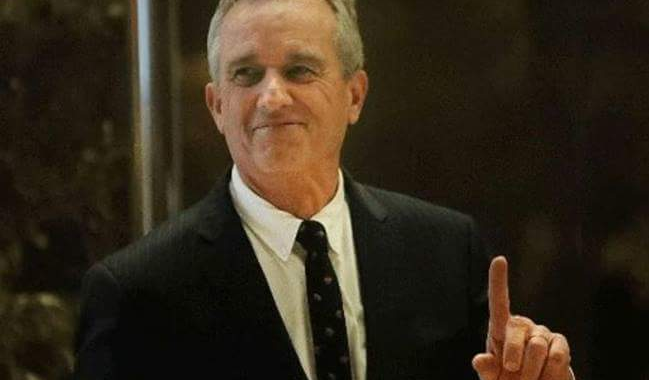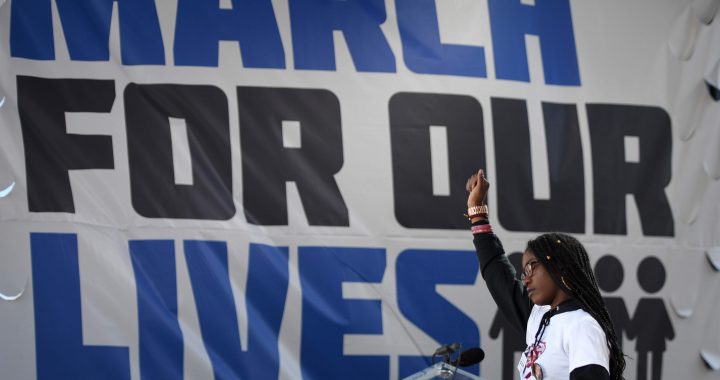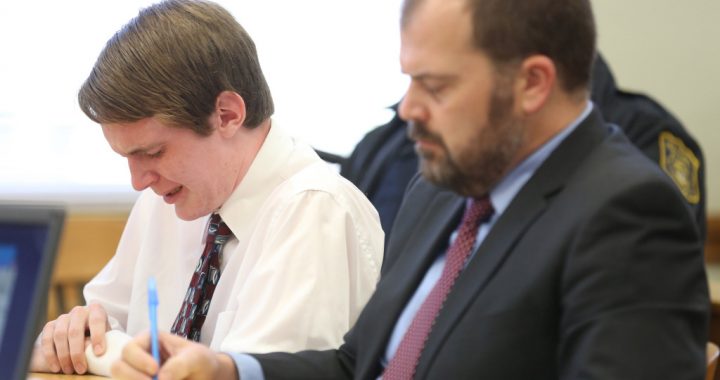Eastridge showed up for duty shortly before the brigade shipped out. He was happy to be there. He never felt more alive than when he was in a war zone.
“It’s almost like a religious experience to see a battlefield,” he said. “To hear the explosions — to see a person bleeding out and die — see everything on fire and smell the smoke and burning flesh. It makes you truly realize what it is to be alive. Combat is the biggest rush you can have.”
Since the start of his first deployment, he had covered himself in tattoos.
On his arm was a memorial to his sergeant killed by a car bomb. On his wrists were red dotted “kill lines” marking where, if needed, he could slit them. On his arm were the twin lightning bolts of the Nazi SS. Wrapping his neck like a collar were the words “BORN TO KILL, READY TO DIE.”
If the Army had followed its own rules, he would not have returned to Iraq for another tour.
Army regulations bar anyone with a pending felony from deploying.
Eastridge was awaiting trial for putting a gun to his girlfriend’s head. He said his commanders knew it.
But when the young soldier showed up and begged his sergeant to let him go back to Iraq, they did. The Army was evasive about if, and why, commanders knowingly deployed Eastridge with a felony hanging over his head.
Eastridge said there was a reason the unit wanted him back. He was one of the best gunners in the battalion.
Soldiers said he was “surgical” with a machine gun and utterly fearless.
“He was really good. If I had 10 Eastridges, my job would be a lot easier,” said his platoon sergeant, Michael Cardenaz.
Eastridge had the most kills of anyone in his company, Cardenaz said.
He was exactly the type of soldier to have in the Heart of Darkness.
Not even the veterans were prepared for how bad Baghdad would be, Eastridge said.
At one point, the unit was losing a soldier a day to the hospital or the morgue.
At first, Eastridge said, he enjoyed the intensity of it. He had a competition going with Bressler to see who could kill more bad guys. His final count, he said — and his sergeant confirmed — was about 80.
But after a few months, the raids, gore and constant threat of roadside bombs started to get to him. He couldn’t sleep. He was on edge all the time. Doctors at the base diagnosed him with PTSD, depression, anxiety and a sleep disorder. They gave him antidepressants and sleeping pills and put him back on duty.
When he went back to the doctors a few weeks later saying the pills were not working, his medical records show, they doubled his dose.
In the spring of 2007, as part of the surge to take back Baghdad, the 500 Lethal Warriors were moved out of their central base into 100-soldier Combat Outposts, known as COPs, scattered in the neighborhoods.
“Once we got to the COPS, it was way worse,” Eastridge said. “We would have mortars and rocket fire and drive-bys every single day.”
. . . Often, his squad would come in from an all-night mission, pull off their body armor, get attacked and have to slap their armor right back on and go out. Sometimes, he said, they wouldn’t sleep for days.
Eastridge’s Iraqi translator introduced him to Valium as a way to relax. At first, he would just take a couple before missions. Then he was taking a couple all the time. Then he was taking a lot more.
Eastridge started to crumble around the same time.
He had been a decorated soldier during his first tour. But in the second, his judgment melted away.
He started searching medicine cabinets for Valium while raiding houses.
Then he started stealing cash and weapons from civilians, which he said he would sell back to the Shiite militia.
He was disciplined by his battalion for stealing once, he said, after he ransacked a house, but only because it belonged to a well-connected man. Most of the time, he got away with it.
He was disciplined again when he flipped out on patrol. Someone shot at his squad from a nearby farmhouse. Eastridge fired about 20 grenades into the house, then stormed in and said he found a farmer and his two dogs in the back and spotted a shell casing from an AK-47 on the ground.
Eastridge demanded to know where the shooter was.
The man said he didn’t know.
Eastridge shot one of the man’s dogs, then asked where the shooter was.
The man said he didn’t know.
Eastridge shot the man’s other dog.
His lieutenant told him he needed to cool off and go sit in the truck.
On the way out, Eastridge passed the man’s herd of a dozen goats. He leveled them with a machine gun. Then he ordered a private to shoot the man’s two cows. Then he shot his horse.
“I was really (expletive deleted) losing it,” Eastridge said, shaking his head.
The Army hasn’t supplied disciplinary records for Eastridge or several other soldiers requested under the Freedom of Information Act, but Eastridge’s account was confirmed by his platoon sergeant.
Eastridge went on one more mission.
He was the gunner manning the M240 machine gun on a Humvee — a big gun that shoots 600 rounds per minute. He said he was ordered to guard the street while the rest of his platoon searched a house.
Eastridge said he told his lieutenant he was going to kill people as soon as the officer was out of sight. Then he asked the driver to put some heavy-metal “killin’ music on.”
His lieutenant laughed and walked off, Eastridge said.
Families were out playing soccer and barbecuing. Eastridge said he just started shooting. He pumped a long burst of rounds into a big palm tree where a few old men had gathered in the shade.
People started running. They piled into their cars and sped away. There was a no-driving rule in effect in the neighborhood, so, Eastridge said, he put his cross hairs on every car that moved.
“All I could think of was car bombs, car bombs, car bombs, and I just kept shooting,” he said.
Orders came over the radio to cease fire, he said, but he kept yelling, “Negative! Negative!”
Eastridge said he shot more than 1,700 rounds. When asked how many people he killed, he said, “Not that many. Maybe a dozen.”
He was court-martialed a short time later on nine counts, including drug possession and disobeying orders. Killing civilians wasn’t one of them.
For that, he said, he was put on guard duty.
Then, in August 2007, sergeants found him with 463 Valium pills in his laundry and a naked female soldier in his bed, according to court testimony. His staff sergeant confronted him about the woman, and Eastridge lashed out, according to his mother, Leanne Eastridge, screaming that he would kill the sergeant, suck out his blood and spit it at his children. Eastridge was court-martialed for disobeying orders and drug possession and sent to a prison camp in Kuwait for a month.
This spring, Eastridge said it was funny that sex and drugs were what got him court-martialed, considering the things he did in Iraq, “Things that can never be told, but that everybody knew about and approved of — basically war crimes.”
He got a health screening as part of the court-martial. Doctors diagnosed him with chronic PTSD, antisocial personality disorder, depression, anxiety and hearing loss. In late September 2007, his commanders decided he was too unstable and dangerous to stay in Iraq, so the Army sent him back to Colorado Springs.
http://www.gazette.com/articles/iframe-59065-eastridge-audio.html
Related Stories/Links
- EDITOR’S NOTE: A word of caution
- Fort Carson report: Combat stress contributed to soldiers’ crimes back home
- Fort Carson report (.pdf document 126 pages)
- Complete military coverage
- Audio: Interview with Kenneth Eastridge
- John Needham letter alleging war crimes
- Casualties of War Part II: Warning signs
Most Viewed Stories
Most Commented Stories
Most Recommended Stories
Save & Share this Article
Casualties of War, Part I: The hell of war comes home
Comments 118 | Recommend 56
Before the murders started, Anthony Marquez’s mom dialed his sergeant at Fort Carson to warn that her son was poised to kill.
It was February 2006, and the 21-year-old soldier had not been the same since being wounded and coming home from Iraqeight months before. He had violent outbursts and thrashing nightmares. He was devouring pain pills and drinking too much. He always packed a gun.
(A word of caution about the language and content of this story: Please see Editor’s Note)
“It was a dangerous combination. I told them he was a walking time bomb,” said his mother, Teresa Hernandez.
His sergeant told her there was nothing he could do. Then, she said, he started taunting her son, saying things like, “Your mommy called. She says you are going crazy.”
Eight months later, the time bomb exploded when her son used a stun gun to repeatedly shock a small-time drug dealer in Widefield over an ounce of marijuana, then shot him through the heart.
Marquez was the first infantry soldier in his brigade to murder someone after returning from Iraq. But he wasn’t the last.
Hear the prison interviews with Kenneth Eastridge.
Marquez’s 3,500-soldier unit — now called the 4th Infantry Division’s 4th Brigade Combat Team — fought in some of the bloodiest places in Iraq, taking the most casualties of any Fort Carson unit by far.
Back home, 10 of its infantrymen have been arrested and accused of murder, attempted murder or manslaughter since 2006. Others have committed suicide, or tried to.
Almost all those soldiers were kids, too young to buy a beer, when they volunteered for one of the most dangerous jobs in the world. Almost none had serious criminal backgrounds. Many were awarded medals for good conduct.
But in the vicious confusion of battle in Iraq and with no clear enemy, many said training went out the window. Slaughter became a part of life. Soldiers in body armor went back for round after round of battle that would have killed warriors a generation ago. Discipline deteriorated. Soldiers say the torture and killing of Iraqi civilians lurked in the ranks. And when these soldiers came home to Colorado Springs suffering the emotional wounds of combat, soldiers say, some were ignored, some were neglected, some were thrown away and some were punished.
Some kept killing — this time in Colorado Springs.
Many of those soldiers are now behind bars, but their troubles still reach well beyond the walls of their cells — and even beyond the Army. Their unit deployed again in May, this time to one of Afghanistan’s most dangerous regions, near Khyber Pass.
This month, Fort Carson released a 126-page report by a task force of behavioral-health and Army professionals who looked for common threads in the soldiers’ crimes. They concluded that the intensity of battle, the long-standing stigma against seeking help, and shortcomings in substance-abuse and mental-health treatment may have converged with “negative outcomes,” but more study was needed.
Marquez, who was arrested before the latest programs were created, said he would never have pulled the trigger if he had not gone to Iraq.
“If I was just a guy off the street, I might have hesitated to shoot,” Marquez said this spring as he sat in the Bent County Correctional Facility, where he is serving 30 years. “But after Iraq, it was just natural.”
More killing by more soldiers followed.
In August 2007, Louis Bressler, 24, robbed and shot a soldier he picked up on a street in Colorado Springs.
In December 2007, Bressler and fellow soldiers Bruce Bastien Jr., 21, and Kenneth Eastridge, 24, left the bullet-riddled body of a soldier from their unit on a west-side street.
In May and June 2008, police say Rudolfo Torres-Gandarilla, 20, and Jomar Falu-Vives, 23, drove around with an assault rifle, randomly shooting people.
In September 2008, police say John Needham, 25, beat a former girlfriend to death.
Most of the killers were from a single 500-soldier unit within the brigade called the 2nd Battalion, 12th Infantry Regiment, which nicknamed itself the “Lethal Warriors.”
Soldiers from other units at Fort Carson have committed crimes after deployments — military bookings at the El Paso County jail have tripled since the start of the Iraq war — but no other unit has a record as deadly as the soldiers of the 4th Brigade. The vast majority of the brigade’s soldiers have not committed crimes, but the number who have is far above the population at large. In a one-year period from the fall of 2007 to the fall of 2008, the murder rate for the 500 Lethal Warriors was 114 times the rate for Colorado Springs.
The battalion is overwhelmingly made up of young men, who, demographically, have the highest murder rate in the United States, but the brigade still has a murder rate 20 times that of young males as a whole.
The killings are only the headline-grabbing tip of a much broader pyramid of crime. Since 2005, the brigade’s returning soldiers have been involved in brawls, beatings, rapes, DUIs, drug deals, domestic violence, shootings, stabbings, kidnapping and suicides.
Like Marquez, most of the jailed soldiers struggled to adjust to life back home after combat. Like Marquez, many showed signs of growing trouble before they ended up behind bars. Like Marquez, all raise difficult questions about the cause of the violence.
Did the infantry turn some men into killers, or did killers seek out the infantry? Did the Army let in criminals, or did combat-tattered soldiers fall into criminal habits? Did Fort Carson fail to take care of soldiers, or did soldiers fail to take advantage of care they were offered?
And, most importantly, since the brigade is now in Afghanistan, is there a way to keep the violence from happening again?
Maj. Gen. Mark Graham, who took command of Fort Carson in the thick of the murders and ordered marked changes in how returning soldiers are treated, said he hopes so.
“When we see a problem, we try to identify it and really learn what we can do about it. That is what we are trying to do here,” Graham said in a June interview. “There is a culture and a stigma that need to change.”
Under his command, nearly everyone — from colonels to platoon sergeants — is now trained to help troops showing the signs of emotional stress. Fort Carson has doubled its number of behavioral-health counselors and tightened hospital regulations to the point where a soldier visiting an Army doctor for any reason, even a sprained ankle, can’t leave without a mental health evaluation. Graham has also volunteered Fort Carson as a testing ground for new Army programs to ease soldiers’ transition from war to home.
Eastridge, an infantry specialist now serving 10 years for accessory to murder, said it will take a lot to wipe away the stain of Iraq.
“The Army trains you to be this way. In bayonet training, the sergeant would yell, ‘What makes the grass grow?’ and we would yell, ‘Blood! Blood! Blood!’ as we stabbed the dummy. The Army pounds it into your head until it is instinct: Kill everybody, kill everybody. And you do. Then they just think you can just come home and turn it off. … If they don’t figure out how to take care of the soldiers they trained to kill, this is just going to keep happening.”
Satan’s throne
The violence started to take root in Iraq’s Sunni Triangle, where the brigade landed in September 2004.
“It was actually beautiful. There were lots of palm trees,” said Eastridge, who is a working-class kid from Kentucky who had never really been anywhere before he joined the Army.
But, he said, “the situation was ugly.”
It was a little more than a year after President George W. Bush had landed on an aircraft carrier in front of a “Mission Accomplished” banner to announce the end of major combat operations. But the situation was growing worse. Rival militias of Sunnis and Shiites were gaining strength. Looting had crippled cities. And in a war with no clear front or enemy, the average monthly body count for U.S. soldiers was up 25 percent from a year earlier.
The brigade was in the worst of it.
None of it bothered Marquez.
In high school, he had been a co-captain on the football team and had run track. After graduation, he joined the infantry because the Army commercials full of guns and helicopters looked like the coolest job in the world.
Eastridge felt the same way. He was the closest thing to a criminal in the group of soldiers later arrested for murder. He was trying to get his life together after growing up with a mother addicted to cocaine. He had been arrested for reckless homicide when he was 12, after he accidentally shot his best friend in the chest while playing with his father’s antique shotgun. He pleaded guilty and was sentenced to counseling. After that, his record had been clean.
Felons cannot join the Army unless they get a waiver from a recruiter. Eastridge said he called a dozen until one told him, “Son, it looks like you just need someone to give you a chance.”
Like Marquez, Eastridge wanted to join the infantry because, he said, “that’s where you get to do all the awesome stuff.”
After basic training, the Army sent both men to South Korea.
They were in different battalions of what became the 4th Brigade Combat Team. Marquez was in the 1st Battalion, 9th Infantry Regiment; Eastridge, the 1st Battalion, 506th Infantry Regiment. Both were foot soldiers. Both were surrounded by other young, gung-ho GIs with no battle experience. And both learned in the spring of 2004 that they were going to Iraq.
“We thought it would be cool. It was what we signed up for,” Marquez said.
It turned out not to be cool at all.
Ramadi, where Marquez landed, had a population the size of Colorado Springs but had no dependable electricity, let alone law and order. Sewage ran in rubble-choked streets. The temperature sometimes rose to 120 degrees.
And when roadside bombs blew civilians to bits, soldiers said, packs of feral dogs fought over the scraps.
Pat Dollard, a documentary filmmaker embedded in the area at the time, wrote that it looked like “Satan had punched a hole in the Earth’s surface, plopped down his throne, and set up shop.”
Marquez was assigned to hunt terrorists in the city. Eastridge patrolled the highway between Ramadi and Fallujah. With him was Bressler, a quiet, friendly gunner later arrested with Eastridge for murder.
Going on a mission usually meant tramping house to house in dust-colored camouflage, loaded down with rifles, pistols, body armor, ammo, grenades and water to fight the incessant heat.
Soldiers went out day and night, knocking on doors — sometimes kicking them in. They set up checkpoints. They seized weapons. They clapped hoods over suspected insurgents. They rarely found terrorists, but the terrorists found them.
A few days into the deployment, a sniper’s bullet killed Marquez’s lieutenant. Then another friend died in a car bombing. Then another.
Combat brigades always take higher casualties than the rest of the Army because they fight on the front lines, but, even by those standards, the 3,500-soldier brigade got pummeled. Sixty-four were killed and more than 400 were injured in the yearlong tour, according to Fort Carson — double the average for all Army brigades that have deployed to Iraq and Afghanistan.
As the insurgents learned their craft, attacks became more gruesome.
A truck loaded with explosives careened into Eastridge’s platoon, killing his squad leader, blowing fist-size holes in his platoon sergeant and pinning the burning engine against the baby of the unit, Jose Barco.
Bombs meant to kill soldiers shredded anyone in the area. Women had their arms ripped off. Old men along the road were reduced to meat.
“It just got sickening,” said David Nash, a then-19-year-old private and Eastridge’s best friend. “There was a massive amount of hate for us in the city.”
One of the jobs of the infantry was to bag Iraqi bodies tossed in the streets at night by sectarian murder squads.
“First thing in the morning, all we would do is bag bodies,” Eastridge said. “Guys with drill bits in their eyes. Guys with nails in their heads.”
Eastridge said he was targeted by snipers twice. Both bullets smashed against walls so close to his face that they peppered his eyes with grit. He laughed at his luck. He loved being a soldier.
In February 2005, Eastridge was in the gun turret of his Humvee when it drove over an anti-tank mine. A deafening flash tore off the front end. Eastridge woke up a few minutes later, several feet from the smoking crater.
He sucked it up. He was bandaged up and sent back on patrol. He said cerebral fluid was leaking out of his ear.
That was the job of the infantry. Eastridge’s battalion was created in World War II and became known as the “Band of Brothers.” It parachuted into Normandy on D-Day and fought in the Battle of the Bulge. In Vietnam, it helped turn back the Tet Offensive and take Hamburger Hill.
Men who heard the stories of past glory almost never got a chance for their own in Iraq. The enemy was invisible. The leading cause of death was hidden roadside bombs.
Sometimes, Marquez felt his only purpose was to drive up and down roads in an armored personnel carrier called a Bradley to clear away hidden bombs.
To unwind, soldiers spent hours playing shoot-’em-up video games. They even played one based on their own unit in Vietnam. They said it offered a release. They could confront a clearly defined enemy. They could shoot, knowing they had the right guy. They could win.
In Ramadi, Marquez and other soldiers said, it felt like they were losing.
“It just seemed like the longer we were there, the worse it got,” said Marquez’s friend in the 1st Battalion, 9th Infantry Regiment, Daniel Freeman.
Freeman was knocked unconscious by a roadside bomb, but the most rattling thing, he said, was driving through the eerie calm, knowing an improvised explosive device, or IED, could kill every soldier in a Humvee without warning, or maybe just smoke one guy in the truck, leaving the others to wonder how, and why, they survived.
Hatred and mistrust simmered between soldiers and locals. Locals who waved to them one day would watch silently as they drove toward an IED the next.
“I’m all about spreading freedom and democracy and everything,” said Josh Butler, another soldier in the 1st Battalion, 506th Infantry Regiment. “But it seems like the Iraqis didn’t even want it.”
Soldiers said discipline started to break down.
“Toward the end, we were so mad and tired and frustrated,” Freeman said. “You came too close, we lit you up. You didn’t stop, we ran your car over with the Bradley.”
If soldiers were hit by an IED, they would aim machine guns and grenade launchers in every direction, Marquez said, and “just light the whole area up. If anyone was around, that was their fault. We smoked ’em.”
Other soldiers said they shot random cars, killing civilians.
“It was just a free-for-all,” said Marcus Mifflin, 21, a friend of Eastridge who was medically discharged with PTSD after the tour. “You didn’t get blamed unless someone could be absolutely sure you did something wrong. And that was hard. So things happened. Taxi drivers got shot for no reason. Guys got kidnapped and taken to the bridge and interrogated and dropped off.”
Soldiers later told El Paso County sheriff’s deputies investigating Marquez for murder that, in Iraq, he got his hands on a stun gun similar to the one he later used on the Widefield drug dealer. They said he used it to “rough up” Iraqis.
Stun guns are banned by the Geneva Conventions. Using one is a war crime, but four soldiers interviewed by The Gazette said a number of soldiers ordered the stun guns over the Internet and carried them on raids. The brigade refused to make other soldiers who served during the tour available for interviews. The Army said it destroys disciplinary records after two years, so it has no knowledge of whether soldiers in the unit were punished.
After 10 months, Marquez said, all he wanted to do was go home.
In June 2005, with a month to go, his platoon was walking across a field when a sniper’s bullet smashed through his best friend’s skull under the helmet.
The platoon circled its guns and grenade launchers, Marquez said, and “tore that neighborhood up.”
That night, Marquez got hit. His squad had just finished hosing his friend’s blood out of their Bradley when they were called out on another mission. They loaded into two Bradleys and rolled toward downtown Ramadi.
Marquez was riding in the dark, cramped rear of the lead Bradley. In a flash, a blast tore through the floor. The engine exploded. Diesel fuel spewed everywhere in a plume of fire. Marquez said he watched the driver scramble out screaming, flames leaping from his clothes.
Marquez and the others clambered into the dark street, rifles ready. Another bomb slammed them to the ground.
Then came a flurry of bullets spitting across the dirt. Marquez was hit four times in the leg.
As blood spurted from his femoral artery, Marquez said, he raised his grenade launcher to return fire and realized the storm of bullets had come from the heavy machine gun on the other Bradley, which had just come around the corner.
“They must have seen our Bradley on fire, figured it was an attack and thought we were all dead,” he said this spring, shaking his head, “then just started shooting.”
According to the Army, two soldiers died. Marquez said three others were wounded. Brigade commanders didn’t make anyone familiar with the incident available.
Marquez was flown to Walter Reed Army Medical Center in Washington, D.C.
He was still bleary on morphine on the Fourth of July weekend that he was told Bush was coming to award him a Purple Heart.
…
[Message clipped] View entire message







